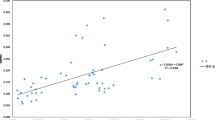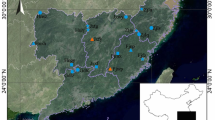Abstract
The genetic diversity and genetic structure of Trillium tschonoskii (Maxim) were investigated using amplified fragment length polymorphism markers. Eight primer combinations were carried out on 105 different individuals sampled from seven populations. Of the 619 discernible DNA fragments generated, 169 (27.3%) were polymorphic. The percentage of polymorphic bands within populations ranged from 4.52 to 10.50. Genetic diversity (HE) within populations ranged from 0.0130 to 0.0379, averaging 0.0536 at the species level. Genetic differentiation among populations was detected based on Nei's genetic diversity analysis (53.03%) and analysis of molecular variance (AMOVA) (52.43%). AMOVA indicated significant genetic differentiation among populations (52.43% of the variance) and within populations (47.57% of the variance) (p < 0.0002). Gene flow was low (0.4429) among populations. Species breeding system and limited gene flow among populations are plausible reasons for the high genetic differentiation observed for this species. We propose an appropriate strategy for conserving the genetic resources of T. tschonoskii in China.
Similar content being viewed by others
References
Ajmone-Marsan, P., Negrini, R., Crepaldi, P., Milanesi, E., Gorni, C., Valentini, A., and Cicogna, M. (2001). Assessing genetic diversity in Italian goat populations using AFLP markers. Anim. Genet. 32:281–288.
Avise, J. C., and Hamrick, J. L. (1996). Conservation Genetics, Case Histories From Nature. Chapman and Hall, New York, pp. 1–9.
Barrett, S. C. H., and Kohn, J. R. (1991). Genetics and evolutionary consequences of small population size in plants: Implications for conservation. In Falk, D. A., and Holsinger, K. E. (eds.), Genetics and Conservation of Rare Plants, Oxford University Press, New York, pp. 3–30.
Curtis, J. M. R., and Taylor, E. B. (2004). The genetic structure of coastal giant salamanders (Dicamptodon tenebrosus) in a managed forest. Biol. Conserv. 115:45–54.
De Knijff, P., Denkers, F., van Swelm, N. D., and Kuiper, M. (2001). Genetic affinities within the herring gull Larus argentatus assemblage revealed by AFLP genotyping. J. Mol. Evol. 52:85–93.
Ellstrand, N. C., and Elam, D. R. (1993). Population genetics consequences of small population size: Implications for plant conservation. Ann. Rev. Ecol. Syst. 24:217–243.
Excoffier, L., Smouse, P. E., and Quattro, J. M. (1992). Analysis of molecular variance inferred from metric distances among DNA haplotypes: Applications to human mitochondrial DNA restriction data. Genetics 131:479–491.
Folkertsma, R. T., Rouppe van der Voort, J. N., de Groot, K. E., van Zandvoort, P. M., Schots, A., Gommers, F. J., Helder, J., and Bakker, J. (1996). Gene pool similarities of potato cyst nematode populations assessed by AFLP analysis. Mol. Plant Microbe Interact. 9:47–54.
Francisco-Ortega, J., Santos-Guerra, A., Kim, S. C., and Crawford, D. J. (2000). Plant genetic diversity in the Canary Islands: A conservation perspective. Am. J. Bot. 87:909–909.
Frankel, O. H., Brown, A. H. D., and Burdon, J. J. (1995). The Conservation of Plant Biodiversity, Cambridge University Press, Cambridge, UK.
Fritsch, P., and Rieseberg, L. H. (1996). The use of random amplified polymorphic DNA (RAPD) in conservation genetics. In Smith, T. B., and Wayne, R. K. (eds.), Molecular Genetic Approaches in Conservation, Oxford University Press, New York, pp. 54–73.
Fukuda, I., and Kozuka, Y. (1958). Evolution and variation in Trillium, 5: A list of chromosome composition in natural populations of Trillium kamtschaticum Pall. J. Fac. Sci. Hokkaido Univ. Ser. 6:273–319.
Fu, L.-G. (1992). Plant Red Book of China: Rare Threatened Plant, Science Publishing House Press, Beijing, pp. 398–399.
Ge, X.-J., Yu, Y., Zhao, N.-X., Chen, H.-Sh., and Qi, W.-Q. (2003). Genetics in the endangered Inner Mongolia endemic shrub Tetraena mongolica Maxim (Zygophyllaceae). Biol. Conserv. 111:427–434.
Haga, T., and Kurabayashi, M. (1954). Genome and polyploidy in the genus Trillium, 5: Chromosomal variation in natural populations of Trillium kamtschaticum Pall. Mem. Fac. Sci. Kyushu Univ. Ser. E. Biol. 1:159–185.
Hamrick, J. L. (1983). The distribution of genetic variation within and among natural plant populations. In Schonewald-Cox, C. M., Chambers, S. M., McBryde, B., and Thomas, W. L. (eds.), Genetics and Conservation, Benjamin/Cummings, Menlo Park, California, pp. 335–348.
Hamrick, J. L., and Godt, M. J. W. (1989). Allozyme diversity in plant species. In Brown, A. H. D., Clegg, M. T., Kahler, A. L., and Weir, B. S. (eds.), Plant Population Genetics: Breeding and Genetic Resources, Sinauer, Sunderland, Massachusetts, pp. 43–63.
Han, T. H., de Jeu, M., van Eck, H., and Jacobsen, E. (2000). Genetic diversity of Chilean and Brazilian Alstroemeria species assessed by AFLP analysis. Heredity 84:564–569.
Hara, H. (1969). New or noteworthy flowering plants from Eastern Himalaya. J. Jpn. Bot. 44:373–378.
Hiroshi, T., and Masashi, O. (2003). Genetic diversity and local population structure of fragmented populations of Trillium camschatcense (Trilliaceae). Biol. Conserv. 109:249–258.
Hogbin, P. M., and Peakall, R. (1999). Evaluation of the conservation of genetic research to the management of endangered plant Zieria prostrata. Conserv. Biol. 13:514–522.
Hunter, M. L. (1996). Fundamentals of Conservation Biology, Blackwell Sciences, London.
Jin, Y., Zhang, W.-J., Fu, D.-X., and Lu, B.-R. (2003). Sampling strategy within a wild soybean population based on its genetic variation detected by ISSR markers. Acta Bot. Sinica 45(8):995–1002.
Kalisz, S. K., Hanzawa, F. M., Tonsor, S. J., Thiede, D. A., and Voigt, S. (1999). Ant-mediated seed dispersal alters pattern of relatedness in a population of Trillium grandiflorum. Ecology 80(8):2620–2634.
Kalisz, S. K., Nason, J. D., and Hanzawa, F. M. (2001). Spatial population genetic structure in Trillium grandiflorum: The roles of dispersal, mating, history, and selection. Evolution 55(8):1560–1568.
Keiper, F. J., and McConchie, R. (2000). An analysis of genetic variation in natural populations of Sticherus flabellatus R. Br. (St. John) using amplified fragment length polymorphism (AFLP) markers. Mol. Ecol. 9:571–581.
Lewontin, R. C. (1972). The apportionment of human diversity. Evol. Biol. 6:381–398.
Loh, J. P., Kiew, R., Set, O., Gan, L. H., and Gan, Y. Y. (2000). Study of genetic variation and relationships within the bamboo subtribe Bambusinae using amplified fragment length polymorphism. Ann. Bot. 85:607–612.
Maki, M. (2003). Population genetics of threatened wild plants in Japan. J. Plant Res. 116:169–174.
Malone, C. L., Knapp, C. R., Taylor, J. F., andDavis, S. K. (2003). Genetic consequences of Pleistocene fragmentation: Isolation, drift, and loss of diversity in rock iguanas (Cyclura). Conserv. Gen. 4:1–15.
Miller, M. P. (1997). Tools for Population Genetic Analysis (TEPGA), Version 1.3. Department of Biological Sciences, Northern Arizona University, Arizona, USA.
Miller, M. P. (1998). AMOVA-PREP 1.01: A program for the preparation of AMOVA input files from dominant-markers raw data. Computer software distributed by author.
Nei, M. (1972). Genetic distance between populations. Am. Nat. 106:283–292.
Nohara, T., Kumamoto, F., Miyahara, K., and Kawasaki, T. (1975). Steroid saponins of aerial parts of Paris tetraphylla A. Gray and of underground parts of Trillium tschonoskii Maxim. Chem. Pharm. Bull. 23(5):1158–1160.
Nybom, H., and Bartish, I. V. (2000). Effects of life history traits and sampling strategies on genetic diversity estimates obtained with RAPD markers in plants. Perspect. Plant Ecol. Evol. Syst. 3:93–114.
Qiu, Y.-X., Hong, D.-Y., Fu, C.-X., and Cameron, K. M. (2004). Genetic variation in the endangered and endemic species Changium smyrnioides (Apiaceae). Biochem. Syst. Ecol. 32(6):583–596.
Reed, D. H. (2003). Correlation between fitness and genetic diversity. Conserv. Biol. 17:230–237.
Rohlf, F. J. (1997). NTSYS-pc: Numerical taxonomy and multivariate analysis system, ver. 2.02. Exeter Ltd., Setauket, NY.
Samejima, K., and Samejima, J. (1962). Studies on the eastern Asiatic Trillium (Liliaceae). Act. Hort. Gotob. 25:157–257.
Schaal, B. A., Leverich, W. J., and Rogstad, S. H. (1991). Comparison of methods for assessing genetic variation in plant conservation biology. In Falk, D. A., and Holsinger, K. E. (eds.), Genetics and Conservation of Rare Plants, Oxford University Press, New York, pp. 123–134.
Slatkin, M. (1985). Gene flow in natural populations. Annu. Rev. Ecol. Syst. 16:393–430.
Uchino, A. (1985a). Chromosomal variation in the K2T genome complex of polyploidy trilliums. Jpn. J. Genet. 60:557–564.
Uchino, A. (1985b). Structure and dynamics of natural populations of polyploid trilliums, 3: A tetraploid species Trillium tschonoskii Maximowicz. Jpn. J. Genet. 60:545–555.
Uchino, A., Takekawa, S., Wang, L., and Takamiya, M. (1997). Cold-treated karyotypes of Trillium tschonoskii var. tschonoskii in a Chinese population. Chromosome Sci. 1:31–33.
Lamote, V., Roldán-Ruiz, I., Coart, E., De Loose, M., Van Bockstaele, E. (2002). A study of genetic variation in Iris pseudacorus populations using amplified fragment length polymorphisms (AFLPs). Aquat. Bot. 73:19–31.
Lucchini, V. (2003). AFLP: A useful tool for biodiversity conservation and management. C. R. Biologies 326:S43–S48.
Vos, P., Hogers, R., Bleeker, M., Reijans, M., van de Lee, T., Hornes, M., Frijters, A., Pot, J., Peleman, J., and Kuiper, M. (1995). AFLP: A new technique for DNA fingerprinting. Nucl. Acids Res. 23:4407–4414.
Watanabe, H., and Kayano, H. (1971). Karyotype analysis of natural populations of Trillium tschonoskii. Jpn. J. Genet. 46:231–234.
Williams, J. G. K., Kubelik, A. R., Livak, K. J., Rafalski, J. A., and Tingey, S. V. (1990). DNA polymorphisms amplified by arbitrary primers are useful as genetic markers. Nucl. Acids Res. 18:6531–6535.
Wu, C.-J., Chen, Z.-Q., Huang, X.-Q., Yin, S.-H., Cao, K.-M., and Sun, C.-R. (2004). Genetic diversity among and within populations of Oryza granulata fromYunnan of China revealed by RAPD and ISSR markers: Implications for conservation of the endangered species. Plant Sci. 1–8.
Yeh, F. C., Yang, R. C., Boyle, T., Ye, Z. H., and Mao, J. X. (1997). Popgene, the User Friendly Shareware for Population Genetic Analysis, Molecular Biology and Biotechnology Center, University of Alberta, Edmonton, Canada.
Yoshitama, K., Oyamada, T., and Yahara, S. (1997). Flavonoids in the leaves of Trillium undulatum Willdenow. J. Plant Res. 110(1099):379–381.
Zou, Y.-P., Ge, S., and Wang, X.-D. (2001). Molecular Markers Used in Systematics and Development Botany, Science Press, Beijing (in Chinese).
Author information
Authors and Affiliations
Corresponding author
Rights and permissions
About this article
Cite this article
Li, Q., Xiao, M., Guo, L. et al. Genetic Diversity and Genetic Structure of an Endangered Species, Trillium tschonoskii. Biochem Genet 43, 445–458 (2005). https://doi.org/10.1007/s10528-005-6782-2
Received:
Accepted:
Issue Date:
DOI: https://doi.org/10.1007/s10528-005-6782-2




